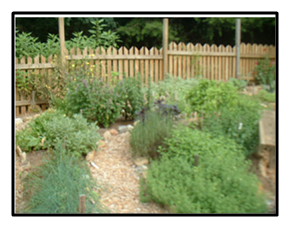
The Roper Mountain Living History Farm, an educational resource for the Greater Greenville community, is owned and operated by the Greenville County School District. The 62-acre site includes cabins and gardens, which represent life in the Upstate in the 1800’s.
http://www.ropermountain.org/
Greater Greenville Master Gardener volunteers help maintain the Heritage, Herb, and Butterfly Gardens on the site. Volunteers also attend the Second Saturday programs at RMSC to help with horticulture questions.
Gardeners maintain vegetables (many heirloom) and herbs grown during that time period, including indigo, Carolina Gold rice, flax, and cotton. In the gardens school children learn about growing vegetables, composting, and practicing organic pest control.
http://www.ropermountain.org/
Greater Greenville Master Gardener volunteers help maintain the Heritage, Herb, and Butterfly Gardens on the site. Volunteers also attend the Second Saturday programs at RMSC to help with horticulture questions.
Gardeners maintain vegetables (many heirloom) and herbs grown during that time period, including indigo, Carolina Gold rice, flax, and cotton. In the gardens school children learn about growing vegetables, composting, and practicing organic pest control.
Kitchen Garden Herbs -
The herb gardens in the 1800’s, known as kitchen gardens, contained all the culinary and medicinal needs of the family. Herbs are easy to grow and use today. See HGIC Fact Sheet 1311.

Medicinal:
- Purple Cone Flower – Echinacea purpurea(herbaceous perennial)
- Mugwort – Artemisia vulgaris (evergreen perennial)
- Wood Betony – Stachys officinalis (herbaceous perennial)
- Yarrow (white) – Achillea millefolium (evergreen perennial)
- Bugleweed – Ajuga reptans (evergreen perennial)
- Southernwood – Artemisia abrotanum (herbaceous perennial)
- Catmint – Nepeta mussinii (herbaceous perennial)
- Yarrow (yellow) – Achillea filipendulina (evergreen perennial)
- Agrimony – Agrimonia eupatoria (herbaceous perennial)
- Lemon Balm – Melissa officinalis (evergreen perennial)
- St. John’s Wort – Hypericum perforatum (evergreen perennial)
- Pennyroyal (English) – Mentha puleguim (evergreen perennial)
- Foxglove – Digitalis purpurea (biennial)
- Feverfew (double) – Chrysanthemum parthenium (evergreen perennial)
- Lamb’s ear – Stachys byzantine (evergreen perennial)
- Passion flower - Passiflora incarnata (herbaceous perennial)
- Spiderwort - Tradescantia virginiana (herbaceous perennial)
- Spanish Needle - Bidens bipinnata (herbaceous perennial)
- Lungwort - Pulmonaria officinalis (herbaceous perennial)
- Hibiscus - Hibiscus coccineus (herbaceous perennial)
- Goldenrod - Solidago sp (herbaceous perennial)
- Teasel (outside fence) - Dipsacus fullonum (biennial)
Dye:
- Soapwort (bouncing bet) – Saponaria officinalis (herbaceous perennial)
- Lady’s Bedstraw – Galium verum (evergreen perennial)
- Comfrey – Symphytum uplandicum (herbaceous perennial)
- Calendual (Pot Marigold) – Calendula officinalis (self-sowing annual)
- Black-eyed Susan – Rudbeckia hirta (herbaceous perennial)
- Coreopsis (herbaceous perennial – self-sowing)
- Hibiscus - Hibiscus coccineus (herbaceous perennial)
- Goldenrod - Solidago sp (herbaceous perennial)
Culinary:
- Savory, Winter – Satureja Montana (evergreen perennial)
- Tarragon, French – Artemisia dracunculus (herbaceous perennial)
- Thyme, lemon – Thymus citrodorus (evergreen perennial)
- Sweet Her of Paraguay – Stevia rebaudiana (herbaceous perennial)
- Anise Hyssop – Agastache foeniculum (herbaceous perennial)
- Sage – Salvia officinalis (evergreen perennial)
- Lovage – Levisticum officinale (herbaceous perennial)
- Rosemary – Rosmarinus officinalis ‘Tuscan Blue’ (Evergreen perennial)
- Chives – Allium schoenoprasum (evergreen perennial)
- Spearmint – Mentha spicata (evergreen perennial)
- Flat Leaf Parsley – Petroselinium crispum ‘Neapolitanum’ biennial
- Speamint - Mentha spicata Perennial
- Basil - Lamiaceae sp Annual
- Jerusalem artichoke - Helianthus tuberosus Herbaceous perennial
- Perilla - Perilla frutescens Annual
- Dill - Anethum graveolens Biennial
Fragrance
- Champney Rose – (evergreen perennial)
- Florentine Iris – Iris germanica var. ‘forentina’ (evergreen perennial)
- ‘Hidcote’ Lavender – Lavandula angustifolia (evergreen perennial)
- Rose Geranium – Pelargonium graveolens (tender evergreen)
Using cotton, flax and wool, farmers made their own clothes.
They used herbs for dye.
They used herbs for dye.
